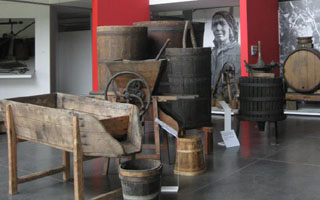Fermentation, soutirage and uses of marc

Once pressed, the grapes designated for domestic use were brought to the cellar (canténna) and poured into vats (tinàz) prepared for this purpose to assure proper sealing. Each vat was filled to within a palm’s distance from the edge, leaving room for the liquid to rise. The must was left to ferment (bóier) for 5 to 12 days. At the end of this phase, a straw (canèla) was inserted into the vat to begin soutirage, the first phase of filtering.
The liquid was transferred into wooden tubs and from there into barrels using a large wooden funnel (salvavènna) or into demijohns (zucòn, damigèna) with a metal funnel (buvinèl, buinèl). In order to allow the fermentation process to continue, both of these containers were temporarily closed with a terracotta or wood bowl (cucòn), with tins punctured with holesor with paper folded into a cone shape. Water was added to the marc that remained in the vats, creating “second” or “half wine” (mèz vén, tarzanèl). Alternatively, the marc could also be extracted from the vat and squeezed through a press (tórc’) to obtain a bitter drink rich in tannins known as la turciadùra.